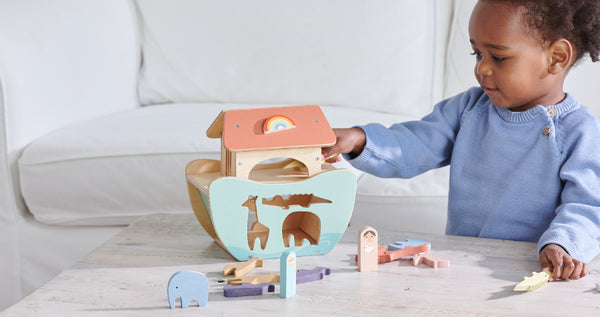Heuristic play | How toddlers learn

Sometimes a toddler prefers the box to the toy that came inside it.
At other times she can spend hours posting objects into holes and taking them out again.
What is going on here? What’s so fascinating about these simple activities?
This heuristic (pronounced hyoo-ristic) play.
Your child is engaged in an exploration. There is something about the material or the possibilities it offers that presses a developmental button. She is primed to find it interesting.
Before children can learn about times tables, reading and science, they have to figure out basic concepts like inside, outside, on top of, through, up, down, before and after.
This is the work of the toddler years. Heuristic play. Repeating actions until they are understood.
Getting more of it is easy. You simply have to follow your child’s interests. Sometimes the kitchen cupboard will be more interesting than the toy box, and that’s OK.
Materials for heuristic play
Play with natural materials is popular. Shells, stones and pine cones look nice on Instagram. But their play value is really no different to straws, buttons and corks. They are better, of course, because they have more interesting textures, tastes and smells. They are irregular and beautiful. But this isn’t an essential ingredient of heuristic play.
What you need are clean, safe, open-ended objects that your child can explore independently. Something is lost if you have to hover anxiously, worried about a choking hazard or sharp edge.
Fortunately, there are plenty of safe but interesting objects to choose from.
Characteristics of a good heuristic material
This isn’t an exhaustive list. Anything works if it comes at the right moment for your child. However, some properties are more interesting than others:
- stackable
- plentiful (e.g. loose parts)
- simple moving parts (such as a flap or toggle)
- hollow, with an opening (such as a box or tube)
- wheeled (or anything else that can be rotated)
- foldable (like fabric)
- connectible
In short, do the materials allow your child to explore the play schemas she is currently focused on?
To begin with, try the following. You’ll soon get the hang of it and come up with ideas of your own.
- Boxes
- Bowls
- Balls
- Cotton reels
- Mirrors (acrylic, child safe)
- Corks
- Wooden spoons
- Yoghurt pots (a variety of sizes, so that they can be nested
- Wooden rings
- Fabric
Toys for heuristic play
Any toy can be used for this kind of play but some are better than others. The best toys are open ended. That means that they can be used in a variety of ways. For example, a wooden block can be stacked, lined up, dropped, floated in water or ‘cooked’ in a pretend saucepan.
- Rainbow tunnel
- Noah’s ark shape sorter
- Wooden blocks
- Block walker
- Cars
- Balls
Final word
Heuristic play is easy. And it fills a vital developmental role.
Don’t worry too much about getting it right - your child instinctively knows what she needs to learn. Your role is simply to provide what early years teachers call an ‘enabling environment’: somewhere safe and calm with interesting materials to hand.
Your child will do the rest.









